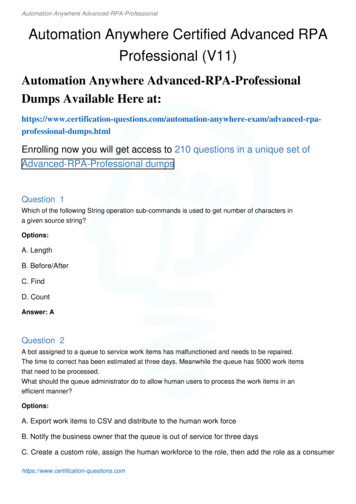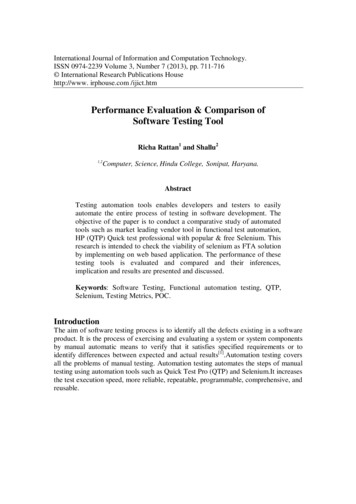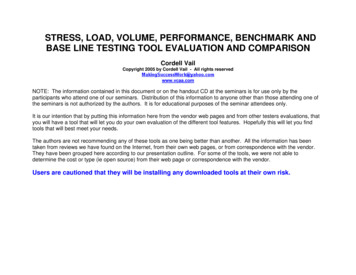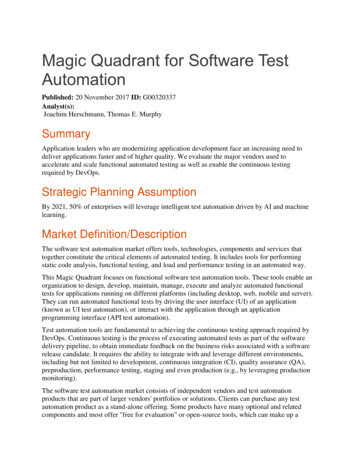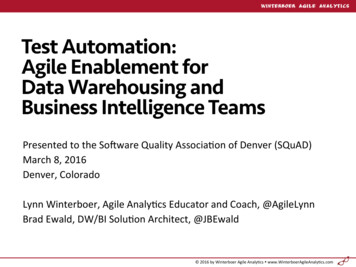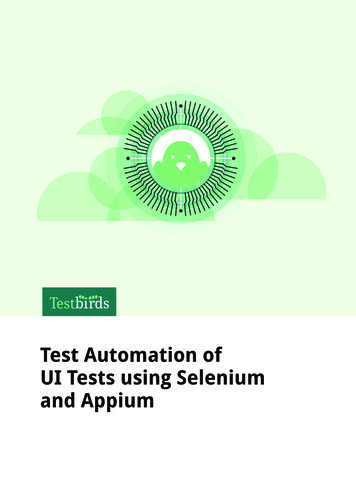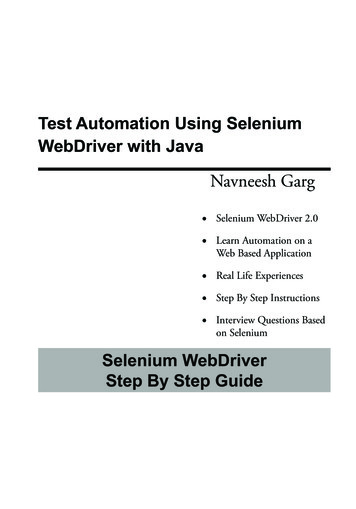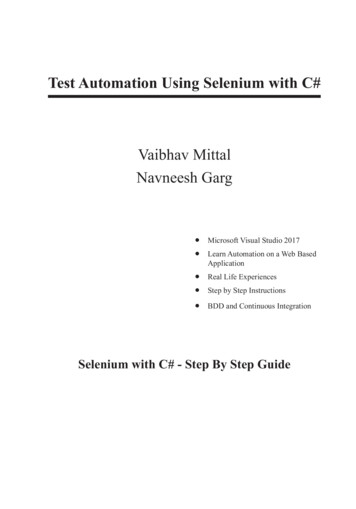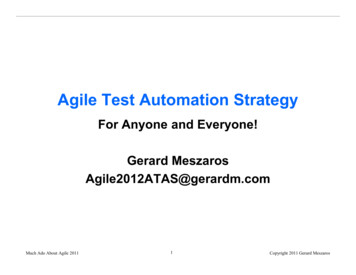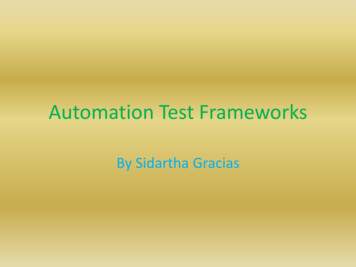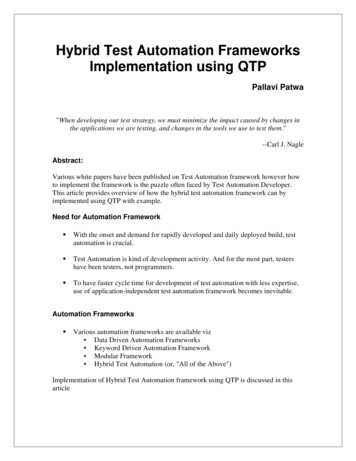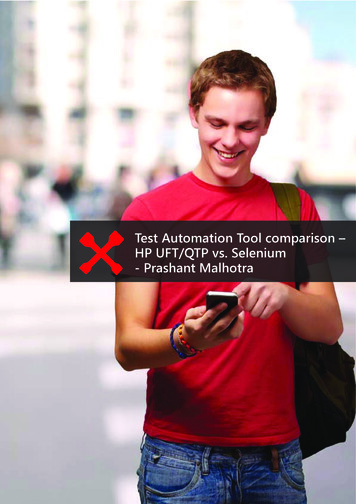
Transcription
Test Automation Tool comparison –HP UFT/QTP vs. Selenium- Prashant Malhotra
Test Automation Tool comparison –HP UFT/QTP vs. Selenium“This whitepaper has been created as a guide to help QA Heads understand, compare and implement industry’s best testautomation tools – HP UFT/QTP and Selenium.”IntroductionIt’s a known fact - Automated testing will shorten development cycles, avoid cumbersome repetitive tasks and improve softwarequality. But how do you get started? Success in any Test Automation (TA) effort lies in identifying the right tool for automation. Thereare so many test automation tools (both open source and commercial) available in the market and it is extremely important to choosethe right tool that best suits your overall requirements. But it is always wise to set a bench mark by comparing HP Quick Test Pro orHP Unified Functional Testing and Selenium as these tools have been the talking point in the automated testing tools market and theyhave acquired majority of the tools market share. So we will start from one of the pioneers in the Test Automation space – HP QuickTest Pro (aka HP UFT).HP Quick Test Pro (QTP) or HP Unified Functional Testing (UFT)Without a doubt, the most dominant commercial player in the market when it comes to functional automation is QTP. It is an easyand extremely user-friendly tool that works well with Windows & Web based applications.Let us talk about the advantages first.a) The primary language is VB script and tool being power-packed with features.Organization doesn’t need to have a skilled coder to write a basic automation script.Its related add-ons give you the flexibility and power to test web-services and servicevirtualization.b) Object repository is one of the greatest features of any commercial tool that automatically suffices a need to be component oriented. This tool is at its best when itcomes to navigation, results validation and reports etc. and Organizations don’t needto worry on integration of QTP with other supporting components.c) QTP is integrated with Quality Center so different high quality dashboards can beconfigured. Another big advantage is different type & level of support you would getin case you run into technical issues. You would always have someone to bank uponfor services & solutions.Now the other side of the coin - Disadvantagesa) QTP is phenomenally costly when you compare it with any open-source orcommercial tools and license cost is entirely dependent on volume and the typeof licenses. On top of it, if you want to have add-ins integrated, you further needto shell out additional hundreds of dollars.b) The licensing cost is not done with one time purchase but it stretches over yearsto come since applications will always mature over a period of time with newfeatures and technology to meet the demands of the competitive market.c) If Organizations upgrade their applications and don’t upgrade QTP, then itwould be technically impossible to sustain automation allowing all the dollarsspent on tool & effort spent by automation resources. Hence, Organization needsto continuously spend to upgrade QTP for new features that support new technology.d) Though the scripting time is less, the execution time is relatively higher as ittakes the entire armor along pushing load on CPU & RAM. Also, it primarily catersto windows environment and limited number of browsers support.02
SeleniumAs a marque tool in open source test automation space, QA decision makers always feel good if something comes to them as a freebieespecially in the cost consuming test automation space. Selenium has the open source edge and moreover it supports a variety of languagesthat include Java, Python, PHP, C#, Ruby and even pure JavaScript. Selenium is at present the most powerful Open Source Automation toolavailable and it is based on java scripting to a large extent. It is more suited for the agile methodology of coding and testing.From the advantages perspective, here are the few:a) Selenium supports many languages such as Java, C#, ruby, python. It doesn’t supportwindows based application but is one of the best tools for web-based automation andsupports all browsers such as IE, FF, Chrome, Safari etc.b) Being into open source world, Selenium can integrate with just about anything to giveyou a robust framework such as Maven or Ant for source code compilation, Test NG todrive tests (unit or functional or integration), Jenkins or Hudson or Cruise Control tointegrate into a Continuous Integration and different reports or dashboards out ofJenkins.c) Selenium also helps you enter bugs or issues into JIRA (Bug management tool) throughJenkins. With the help of Jenkins or Grid, testers can connect multiple nodes to run different tests in parallel.d) Cost is the biggest advantage as it is a freeware and is integrated with other opensource tools. As mentioned above, the only cost that you need to spend is on the humanresource (single or team) who knows all of the above stuff.Now let us look into the disadvantages part.a) Organizations need to invest in a resource who knows coding as per standards. Theresource should also be well versed in framework architecture and various componentsthat fit in.b) Tool support is done by way of communities and more and more people are joiningtogether to contribute to provide solutions and support free-ware. But issues may notbe addressed in the next release cycle like any other commercial vendors do routinely.So it can potentially leave Organizations themselves to find a solution on their own andcontribute to community or wait for someone to give a solution.Comparison Matrix:FeatureQTP(UFT)SeleniumLanguage SupportVB ScriptJava, C#, Ruby, Python, PerlPHP , JavascriptWindows (Non-browser)based Application supportYesNoBrowser supportGoogle Chrome (uptill ver 23)Internet Explorer , Firefox ( ver 21)Google Chrome , Internet Explorer ,Firefox , Opera , HtmlUnitEnvironment SupportOnly WindowsWindows , Linux , SolarisOS X , Others (If brower & JVM orJavascript support exists)03
FeatureQTP(UFT)SeleniumDifferent commercial product i.e.HP UFT Mobile (formerly known asMobileCloud for QTP)Android , iPhone & iPad ,Blackberry , Headless WebKitFrameworkEasily integrated with HP QualityCenter or HP ALM (separatecommercial products)Selenium Eclipse Maven / ANT Jenkins / Hudson & its plugins /Cruise Control TestNG SVNContinuous IntegrationPossible through Quality Center/ ALM or JenkinsPossible through Jenkins / Hudson/ Cruise ControlObject Recognition/ StorageInbuilt Object Repository (storingElement Id, multiple attributes) alongwith weightage that gives flexibilityon deviation acceptance in controlrecognitionUI Maps and different object locationstrategy such as -XPath Element IDor attribute DOMImage based TestsEasily possiblePossible but not easyReportsQuality Center has in-built awesomedashboardsIntegration with Jenkins can givegood reporting & dashboardcapabilitiesSoftware CostLicense & Annual maintenancefeesZeroCoding Experience ofEngineerNot MuchShould be very good along withtechnical capabilities of integratingdifferent pieces of frameworkScript Creation TimeLessHighHardware resource (CPU RAM) consumption duringscript executionHighLowDedicate HP support along withsupport forumsOpen Source CommunityMobile (Phones & Tablets)supportProduct SupportConclusionAt the end of the day it is as simple between buying a branded car and assembling a car on your own. Branded car has its cost & servicesattached whereas in assembled car, you need to take care of everything on your own. But, there is a hybrid solution where you can go to acustom workshop to get an assembled car (sales and post-sales support) and pay for their services.The same concept is now available in IT too such as you go to a service provider who has everything i.e. who has developed automationframeworks using different open source components, who has coders ready to put in muscle & tissue to the pre-existing wire-frame anddeliver it to you. This concept is the new trend in town and many companies have switched to open source frameworks built by serviceproviders thereby reducing their overall product cost.04
ABOUT ASPIRE SYSTEMSAspire Systems is a global technology services firm serving as a trusted technology partner for our customers. We work with someof the world's most innovative enterprises and independent software vendors, helping them leverage technology and outsourcingin our specific areas of expertise. Our services include Product Engineering, Enterprise Transformation, Independent Testing Servicesand IT Infrastructure Support servicesOur core philosophy of "Attention. Always." communicates our belief in lavishing care and attention on our customers andemployees.USAINDIAAspire Systems, Inc.1735 Technology DriveSuite 260, San Jose, CA - 95110, USATel: 1-408-260-2076, 1-408-260-2090Fax: 1-408-904-4591E-mail: info@aspiresys.comAspire Systems (India) Pvt. Ltd.1/D-1, SIPCOT IT PARKSiruseri, Chennai - 603 103Tamil Nadu, IndiaTel: 91-44-6740 4000Fax: 91-44-6740 4234E-mail: info-india@aspiresys.comUKAspire Systems1, Lyric Square, HammersmithLondon - W6 0NB, UKTel: 44 203 170 6115E-mail: info@aspiresys.com05
a) QTP is phenomenally costly when you compare it with any open-source or commercial tools and license cost is entirely dependent on volume and the type of licenses. On top of it, if you want to have add-ins integrated, you further need to shell out additional hundreds of dollars.File Size: 858KBPage Count: 5
